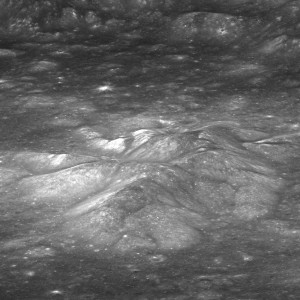
Pictured is the central peak of Bullialdus rising above the crater floor with the crater wall in the background. Image Credit: NASA/GSFC/Arizona State University
The Earth’s moon is taking on more of a wet look.
Scientists have detected “magmatic water” on the surface of the Moon, that is, water that originates from deep within the Moon’s interior.
Fresh data about water on the Moon has been percolating for several years.
For one, new laboratory techniques used to investigate Apollo lunar samples revealed that the interior of the Moon is not as dry as we previously thought.
Also, information gleaned from spacecraft orbiting the Moon detected water on the lunar surface, which is thought to be a thin layer formed from solar wind hitting the lunar surface.
Crater Bullialdus
Now scientists are looking at the first remote detection of this type of lunar water, arrived at by using data from NASA’s Moon Mineralogy Mapper (M3) that was toted into lunar orbit by the Indian Space Research Organization’s Chandrayaan-1 spacecraft.
In 2009, the M3 fully imaged the lunar impact crater Bullialdus.
After examining the M3 data, Rachel Klima, a planetary geologist at the Johns Hopkins University Applied Physics Laboratory (APL) in Laurel, Md. and her colleagues found that the crater has significantly more hydroxyl compared to its surroundings.
Hydroxyl is a molecule consisting of one oxygen atom and one hydrogen atom.
“The hydroxyl absorption features were consistent with hydroxyl bound to magmatic minerals that were excavated from depth by the impact that formed Bullialdus crater,” Klima explains.
Native lunar water
“Understanding this internal composition helps us address questions about how the Moon formed, and how magmatic processes changed as it cooled. There have been some measurements of internal water in lunar samples, but until now this form of native lunar water has not been detected from orbit,” says Klima.
According to Justin Hagerty of the U.S. Geological Survey: “This surficial water unfortunately did not give us any information about the magmatic water that exists deeper within the lunar crust and mantle, but we were able to identify the rock types in and around Bullialdus crater.”
Hagerty added that such studies can help understand how the surficial water originated and where it might exist in the lunar mantle.
Lunar mantle
“This impressive research confirms earlier lab analyses of Apollo samples, and will help broaden our understanding of how this water originated and where it might exist in the lunar mantle,” said NASA Lunar Science Institute Director, Yvonne Pendleton.
Along with Klima and Hagerty, Joshua Cahill and David Lawrence, both of APL, detailed the new research in a co-authored paper published in the August 25 issue of Nature Geoscience: “Remote detection of magmatic water in Bullialdus Crater on the Moon.”
The research was supported by the NASA Lunar Advanced Science and Engineering Program, NLSI and the NASA Planetary Mission Data Analysis Program.
By Leonard David
